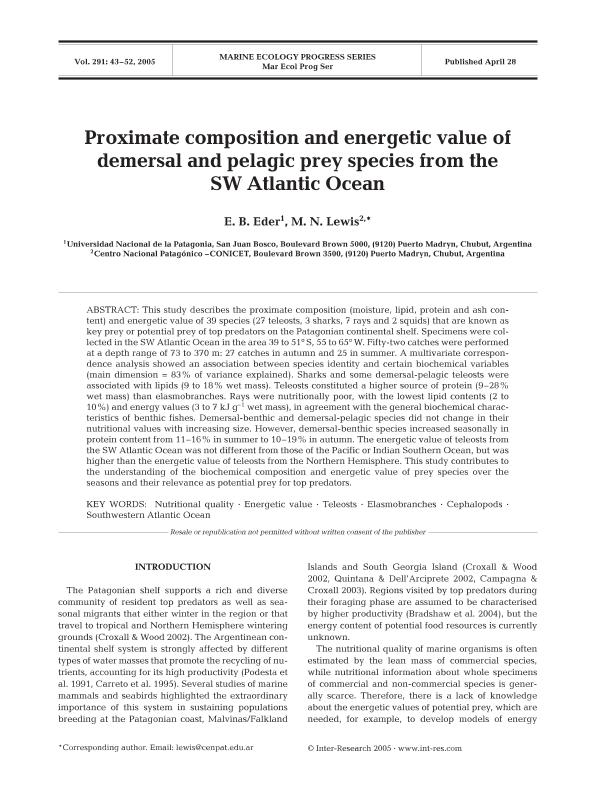Mostrar el registro sencillo del ítem
dc.contributor.author
Eder, Elena Beatriz

dc.contributor.author
Lewis, Mirtha Noemi

dc.date.available
2020-05-06T14:46:42Z
dc.date.issued
2005-12
dc.identifier.citation
Eder, Elena Beatriz; Lewis, Mirtha Noemi; Proximate composition and energy value of demersal and pelagic prey species from Southwest Atlantic; Inter-Research; Marine Ecology Progress Series; 291; 12-2005; 43-52
dc.identifier.issn
0171-8630
dc.identifier.uri
http://hdl.handle.net/11336/104321
dc.description.abstract
This study describes the proximate composition (moisture, lipid, protein and ash content) and energetic value of 39 species (27 teleosts, 3 sharks, 7 rays and 2 squids) that are known as key prey or potential prey of top predators on the Patagonian continental shelf. Specimens were collected in the SW Atlantic Ocean in the area 39 to 51°S, 55 to 65°W. Fifty-two catches were performed at a depth range of 73 to 370 m: 27 catches in autumn and 25 in summer. A multivariate correspondence analysis showed an association between species identity and certain biochemical variables (main dimension = 83% of variance explained). Sharks and some demersal-pelagic teleosts were associated with lipids (9 to 18% wet mass). Teleosts constituted a higher source of protein (9–28% wet mass) than elasmobranches. Rays were nutritionally poor, with the lowest lipid contents (2 to 10%) and energy values (3 to 7 kJ g–1 wet mass), in agreement with the general biochemical characteristics of benthic fishes. Demersal-benthic and demersal-pelagic species did not change in their nutritional values with increasing size. However, demersal-benthic species increased seasonally in protein content from 11–16% in summer to 10–19% in autumn. The energetic value of teleosts from the SW Atlantic Ocean was not different from those of the Pacific or Indian Southern Ocean, but was higher than the energetic value of teleosts from the Northern Hemisphere. This study contributes to the understanding of the biochemical composition and energetic value of prey species over the seasons and their relevance as potential prey for top predators.
dc.format
application/pdf
dc.language.iso
eng
dc.publisher
Inter-Research

dc.rights
info:eu-repo/semantics/openAccess
dc.rights.uri
https://creativecommons.org/licenses/by-nc-sa/2.5/ar/
dc.subject
NUTRITIONAL QUALITY
dc.subject
ENERGETIC VALUE
dc.subject
TELEOST
dc.subject
ELASMOBRANCHES
dc.subject
CEPHALOPODS
dc.subject
SOUTHWEST ATLANTIC OCEAN
dc.subject.classification
Conservación de la Biodiversidad

dc.subject.classification
Ciencias Biológicas

dc.subject.classification
CIENCIAS NATURALES Y EXACTAS

dc.title
Proximate composition and energy value of demersal and pelagic prey species from Southwest Atlantic
dc.type
info:eu-repo/semantics/article
dc.type
info:ar-repo/semantics/artículo
dc.type
info:eu-repo/semantics/publishedVersion
dc.date.updated
2020-04-22T15:38:46Z
dc.identifier.eissn
1616-1599
dc.journal.volume
291
dc.journal.pagination
43-52
dc.journal.pais
Alemania

dc.conicet.avisoEditorial
Early volumes (more than five years since publication) are freely accessible to all users. They are listed according to the subscription year to which they belonged.
dc.description.fil
Fil: Eder, Elena Beatriz. Universidad Nacional de la Patagonia "San Juan Bosco"; Argentina
dc.description.fil
Fil: Lewis, Mirtha Noemi. Consejo Nacional de Investigaciones Científicas y Técnicas. Centro Nacional Patagónico; Argentina
dc.journal.title
Marine Ecology Progress Series

dc.relation.alternativeid
info:eu-repo/semantics/altIdentifier/url/https://www.int-res.com/abstracts/meps/v291/p43-52/
dc.relation.alternativeid
info:eu-repo/semantics/altIdentifier/doi/http://dx.doi.org/10.3354/meps291043
Archivos asociados
